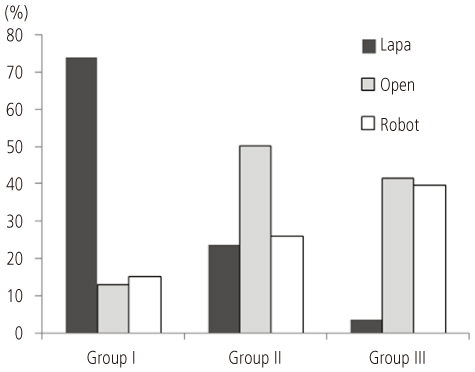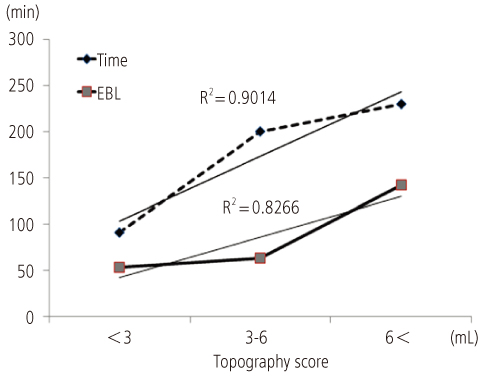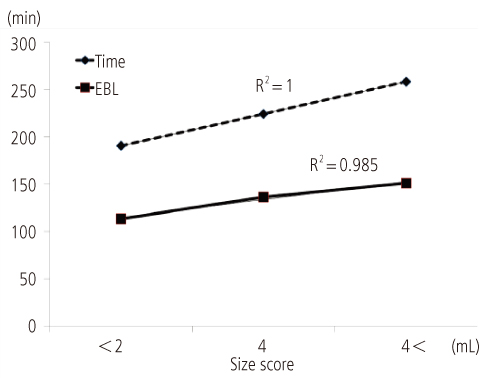Korean J Obstet Gynecol.
2012 Mar;55(3):172-179. 10.5468/KJOG.2012.55.3.172.
Laparoscopic myomectomy: Presurgical classification to evaluate the validity of laparoscopic surgical treatment
- Affiliations
-
- 1Department of Obstetrics and Gynecology, The Catholic University of Korea School of Medicine, Seoul, Korea. janghkim@catholic.ac.kr
- KMID: 2274122
- DOI: http://doi.org/10.5468/KJOG.2012.55.3.172
Abstract
OBJECTIVE
To evaluate if the preoperative scoring system effect the post operative prognosis and type of operation.
METHODS
Patients who took myomectomy in Seoul St. Mary's Hospital were enrolled this study. Retrospective analysis of preoperative leiomyoma scroings with imaging study were done. Prognostic factors were as follows: hospital days, bleeding amount, transfusion rate, operation time. Catholic Medical Center fibroid score system (CMFS) was used for analysis of fibroid.
RESULTS
Patients were grouped into three as CMFS total score. Group I: scores<11, group II: 11-20, group III: 20<. Bleeding amount was 106.0 mL in group I, 132.3 mL in group II and 135.6 mL in group III. The bleeding amount and transfusion rate were significantly low in group I (P<0.05). Total score of CMFS had significant effect to type of operation (odds ratio, 1.339; 95% confidence interval, 1.237 to 1.449, P<0.0001; area under curve, 0.810) and accuracy was 76.6%. Topographic score and size score effect significantly to bleeding amount and operation time Topography score coefficient of determination (CD, 0.90, 0.82, P<0.01; size score CD, 1, 0.98, P<0.01). Repair score showed significant correlation with operation time, but showed no correlation with bleeding amount and operation time. Topographic score, size score, repair score showed significant effect on type of operation (P<0.01).
CONCLUSION
Systematic scoring systems like CMFS help to predict the difficulties and bleeding complications after myomectomy. Further study about preoperative the prognostic factors and accurate presurgical scoring system were helpful for the decision of type of operation.
Keyword
Figure
Reference
-
1. Falcone T, Bedaiwy MA. Minimally invasive management of uterine fibroids. Curr Opin Obstet Gynecol. 2002. 14:401–407.2. Holub Z. Laparoscopic myomectomy: indications and limits. Ceska Gynekol. 2007. 72:64–68.3. Agdi M, Tulandi T. Endoscopic management of uterine fibroids. Best Pract Res Clin Obstet Gynaecol. 2008. 22:707–716.4. Sinha R, Hegde A, Mahajan C, Dubey N, Sundaram M. Laparoscopic myomectomy: do size, number, and location of the myomas form limiting factors for laparoscopic myomectomy? J Minim Invasive Gynecol. 2008. 15:292–300.5. Lasmar RB, Barrozo PR, Dias R, Oliveira MA. Submucous myomas: a new presurgical classification to evaluate the viability of hysteroscopic surgical treatment: preliminary report. J Minim Invasive Gynecol. 2005. 12:308–311.6. Deprez PH, Bergman JJ, Meisner S, Ponchon T, Repici A, Dinis-Ribeiro M, et al. Current practice with endoscopic submucosal dissection in Europe: position statement from a panel of experts. Endoscopy. 2010. 42:853–858.7. Hurst BS, Matthews ML, Marshburn PB. Laparoscopic myomectomy for symptomatic uterine myomas. Fertil Steril. 2005. 83:1–23.8. Glasser MH. Minilaparotomy myomectomy: a minimally invasive alternative for the large fibroid uterus. J Minim Invasive Gynecol. 2005. 12:275–283.9. Reich H, Thompson KA, Nataupsky LG, Grabo TN, Sekel L. Laparoscopic myomectomy: an alternative to laparotomy myomectomy or hysterectomy? Gynaecol Endosc. 1997. 6:7–12.10. Mais V, Ajossa S, Guerriero S, Mascia M, Solla E, Melis GB. Laparoscopic versus abdominal myomectomy: a prospective, randomized trial to evaluate benefits in early outcome. Am J Obstet Gynecol. 1996. 174:654–658.11. Miller CE, Johnston M, Rundell M. Laparoscopic myomectomy in the infertile woman. J Am Assoc Gynecol Laparosc. 1996. 3:525–532.12. Daraï E, Dechaud H, Benifla JL, Renolleau C, Panel P, Madelenat P. Fertility after laparoscopic myomectomy: preliminary results. Hum Reprod. 1997. 12:1931–1934.13. Marret H, Chevillot M, Giraudeau B. Study Group of the French Society of Gynaecology and Obstetrics (Ouest Division). Factors influencing laparoconversions during the learning curve of laparoscopic myomectomy. Acta Obstet Gynecol Scand. 2006. 85:324–329.14. Dubuisson JB, Fauconnier A, Fourchotte V, Babaki-Fard K, Coste J, Chapron C. Laparoscopic myomectomy: predicting the risk of conversion to an open procedure. Hum Reprod. 2001. 16:1726–1731.15. Frishman GN, Jurema MW. Myomas and myomectomy. J Minim Invasive Gynecol. 2005. 12:443–456.
- Full Text Links
- Actions
-
Cited
- CITED
-
- Close
- Share
- Similar articles
-
- Hybrid laparoscopic myomectomy: A novel technique
- Surgical outcomes for robot-assisted laparoscopic myomectomy compared with laparoscopic myomectomy
- Clinical experience with single-port access laparoscopic cystectomy and myomectomy
- Disseminated Peritoneal Leiomyomatosis Following Previous Laparoscopic Myomectomy with Morcellation
- Learning Curve of Laparoscopic Myomectomy




